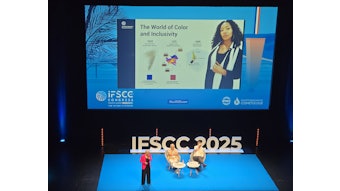The Society of Cosmetic Chemists (SCC) returned this week to New York for an on-site (and online) Scientific Meeting and Showcase. From Dec. 13-15, 2021, attendees will: reflect on the SCC's 75 years; explore advances in natural, cleaner and milder formulations; focus on diversity in beauty; seek to advance makeup and hair care; learn new findings of cannabinoids (CBDs) and the skin microbiome; take a sustainability deep dive and more.
Structure, Properties and Care of Curly Hair
A comprehensive evaluation of the structure and properties of curly hair, especially in comparison with those of straight hair, was performed and presented by Ali N. Syed, Ph.D. and Maliha Syed, Ph.D., both of Avlon Industries.
Curly hair samples were collected from African-descent individuals and were categorized as hair Type 3 or hair Type 4. Straight hair samples were collected from Caucasian individuals and were categorized as hair Type 1. Hair samples with varying degrees of curl were evaluated for porosity; ease of wet and dry combing; elasticity; tensile strength; fiber ellipticity; moisture content; and the number of twists along the hair shaft.
Extensive hair typing was undertaken to characterize fibers according to curl diameter, curl index, curvature, and number of twists and waves. Trends were established to understand how these properties incrementally change with increasing degrees of curl. Additionally, the scalp’s moisture content and transepidermal water loss (TEWL) were quantified and compared between African and Caucasian individuals. Based on the findings herein, conditioning agents, as well as styling and maintenance techniques for each specific hair type were established.
Featured: Testing Tactics in Hair: Beyond Biology—Why African Hair is Fragile*
The research concluded Type 3 and 4 hair fibers required higher combing energy in both the wet and dry states than Type 1 hair fibers. Type 1 fibers exhibited higher tensile strength and greater elasticity as compared with Type 3 and Type 4 hair fibers. While Type 1 hair fibers were cylindrical in shape, showing an ellipticity of ~1.0-1.40, Type 3 and 4 hair fibers were oval in shape, exhibiting higher ellipticity values of 1.0-3.0.
"Of course, we plan on expanding our studies," said Maliha Syed. "We are planning on expanding to more hair types. We're in the process to procure examples of Type 2 and Type 3 fibers. We're also looking of course to larger sample sizes and we'll be looking at additional physical properties such as fiber porosity."
Within a single hair fiber, the variance in ellipticity was much higher for Type 3 and 4 hair fibers as compared with Type 1 fibers. An increase in fiber porosity was observed as the hair fiber increased in degree of curl. The moisture content of Type 1 hair fibers was greater than Type 3 and 4 hair fibers at both low and high humidity levels. The moisture content of the Caucasian scalp was greater than that of the African-descent scalp.
Diversity in Beauty
Diversity goes beyond the center stage or a marketing campaign. Consumers are seeking out products that are personalized for them in addition to pushing inclusivity and transparency from the brand. This industry has a different array of colors, textures, shapes and sizes, which create a unique blend of cultures and backgrounds. The challenge of diversity is not only ensuring representation of historically underrepresented groups but the challenge of diversity is also creating an environment where “we” is everyone. This presentation from Cynthia Johnson of Cindy J Cosmetic Labs, LLC shows four different stages of challenges found today in the beauty industry: race, gender neutrality, age and careers.
"People of color just feel neglected," stated Johnson. "It goes along as alienation from their coworkers. Employees want to feel included and valued within their company. So one way that you [brand owners] can create that connection and bring that connection back with your employees is by creating diversity within your organization. This is to bring a voice with fresh insights, experiences and intuition, and to bring disruption and innovation into the industry."
Johnson concluded that the beauty industry can only be accomplished if there is diversity and inclusion within its brand. Brand companies have started to educate themselves on different cultures and created ways they can include people of color. Hiring diverse groups of people as important decision-makers brings better business decisions, understanding of the consumer’s values and authenticity to provide representation.
Meeting Diverse Needs: The R&D Approach
Global research and development efforts in skin health and beauty endeavor to meet the needs of a highly diverse consumer population, considering a range of skin tones, types and conditions. Inclusive innovation strategy incorporates an end-to-end approach when conducting fundamental skin biology research to develop new technologies and products.
Driving and executing an expansive diversity strategy requires an understanding of consumer needs from multicultural and diverse KOL insights, expansion of preclinical skin models, and inclusive clinical study and product efficacy validation strategies.
Recent highlights from Barbara Green, Johnson & Johnson Consumer Health R&D on these efforts were shared as the industry strives to better serve a diverse consumer population.
Green discussed some of the top concerns people of color are facing such as acne, eczema and hyperpigmentation. "[Acne] is very important among people of color and one of the important elements to understand is that within Black patients, there's an associated increase in intense inflammation. This intense inflammation can be what helps trigger the strong link in post-inflammatory hyperpigmentation that occurs with acne in people of color and also the disfiguring form of hypertrophic scarring."
Green continued: "As we're developing products and treatments for people of color, acne and hyperpigmented macules are present in almost two-thirds of Black patients that have acne. [It is also present] in a high percentage of Hispanic patients and Asian patients—and so this is an ongoing need [for consumers of color]."
"So how can we be more inclusive in R&D?" Green asked. "What can we do to help first understand and then bring some new solutions to our increasingly diverse population, and to work with our dermatologist to help educate and inform [consumers]."
In addition to skin concerns among consumers of color, Green also presented the difference between sunscreen and sun care research with consumers of color and white consumers.
". . .There is some inherent protection on darker skin tones with a higher melanin content. However, that level of protection is fairly mild," explained Green. "The American Academy of Dermatology recommends that all people, regardless of race or ethnicity, use sunscreen as part of their sun-safe practices to avoid skin cancers and some of the other consequences from the sun."
Green continued: "There's a significant lack of education in terms of the need for sunscreen in this population. . . we asked, 'how did they experience sunburn over the last year?' And the key takeaways that we had were. . . the primary symptom of sun exposure and sunburn. It's intuitive that the lighter skin tones. . . are more prone to burning I think we need to make sure we're communicating to all ethnicities and races on the importance of some sun protection. We found that as the skin becomes darker, skin type 5 [of the Fitzpatrick photo types] or African-descent saw that peeling is actually the primary symptom of sun exposure and sunburn."










